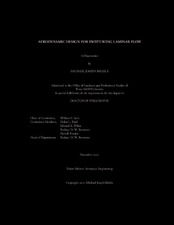Aerodynamic Design for Swept-wing Laminar Flow
Abstract
This work describes and compares processes for swept-wing laminar flow control (SWLFC) aerody-namic design. It focuses on results obtained during the preliminary outer-mold-line (OML) design of the Subsonic Aircraft Roughness Glove Experiment (SARGE), a natural laminar flow and passive laminar flow control wing glove flight experiment funded by the NASA Environmentally Responsible Aviation initiative. The experiment seeks to raise the technology readiness level of the spanwise-periodic discrete roughness element (DRE) SWLFC technique for transition delay on a swept wing.
Changes to the SARGE project requirements necessitated numerous redesigns that lead to design process insights and reinforced the value of proven methodologies. Optimization-based wing design methods are compared to traditional processes in the context of issues specific to SWLFC design. A refined traditional process incorporates the lessons learned during SARGE design excursions. As 3D effects are often significant at transonic Mach numbers, they should be included in the analysis as soon as practical when allowing for available computational tools.
In the initial experimental feasibility and OML design, Euler computational fluid dynamics was used to produce a series of 2.5D SWLFC airfoils with boundary-layer stability and transition predicted using linear stability theory and the e^(N) method. Two wing gloves were lofted onto the Gulfstream-III host aircraft wing: TAMU-05-04, a straight loft using the TAMU2D-04 airfoils, and TAMU-06-05, an optimized revision used in the preliminary design review (PDR) of the SARGE experiment conducted in June 2012. The target pressure distribution for the TAMU-06-05 glove was developed using a graphical B-spline method.
The SARGE PDR identified a few issues that need to be addressed in order to ensure a successful experiment, which includes isobar unsweep that adversely affects boundary layer stability for DRE control and potential flow separation at the inboard fairing. Using the refined process, an alternate planform is evaluated as a potential starting point to address these issues and is shown to be feasible.
Subject
aircraftaerodynamic design
boundary-layer stability
boundary-layer transition
crossflow instability
discrete roughness elements
drag reduction
flight test
laminar flow control
natural laminar flow
swept-wing laminar flow control
wing design
wing glove
Citation
Belisle, Michael Joseph (2013). Aerodynamic Design for Swept-wing Laminar Flow. Doctoral dissertation, Texas A & M University. Available electronically from https : / /hdl .handle .net /1969 .1 /151655.


